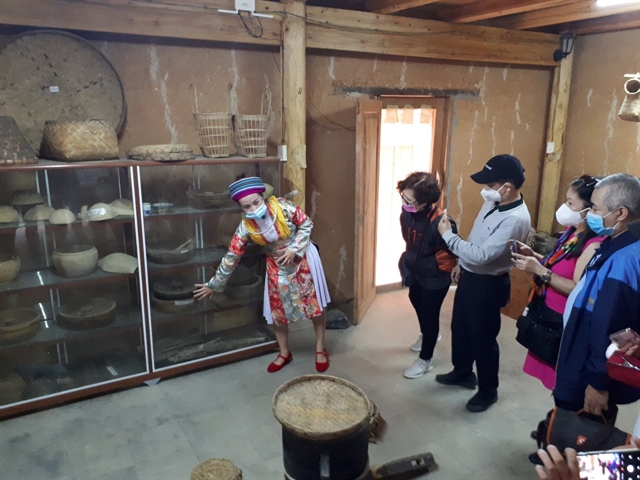 Society
Society


|
| Tourists learn about Mông ethnic culture in Mèo Vạc District, Hà Giang Province. — VNA/VNS Photo |
HÀ GIANG — With great advantages and attractive tourism products, the northernmost province of Hà Giang has been striving to meet visitors’ changing demands when entering the new normal stage.
Located at the highest latitude in Việt Nam, Hà Giang is neighboured by Cao Bằng on the east, Tuyên Quang on the south, Lào Cai and Yên Bái on the west. It shares a 274km border with China
Hà Giang's complicated topography is divided into three areas. The area on the south has rocky mountains, separated by rivers. The west area has sloping mountainsides, high passes, valleys, and narrow springs. The low land area includes hills, the valley of Lô River, and Hà Giang Town.
When visiting the northernmost province, tourists are attracted by the natural landscape, Đồng Văn Highland, and the Love Market of Khâu Vai. They can buy embroidered items like handkerchiefs, bags, and dresses with colourful patterns.
Nguyễn Anh Tuấn, head of the Institute for Tourism Development Research (ITDR), an affiliate of the Vietnam National Administration of Tourism, said that that the province had the potential to offer border tourism, urging mechanisms and investments to promote this kind of tourism.
It was necessary to build and improve infrastructure, for example, roads to better link tourist attraction locations, he said.
Once developing tourism products, the province has to pay proper attention to preserving natural resources and the environment, Tuấn said.
Phùng Quang Thắng, Director of Hanoitourist Travel Company, said after COVID-19, tourists were interested in adventure tourism with activities like caravaning, mountain climbing, paragliding and cave exploration.
Hà Giang had great advantages and potential to offer such adventure tourism products, he said, adding that to develop the products, it was necessary to apply safety standards and technological solutions in managing adventure tourism destinations
Thắng added that at this time, tours for small groups of tourists were suitable to meet COVID-19 prevention and control measures.
Hà Giang Province should focus on measures to properly manage destinations and develop closed tours that would help ensure safety for tourists, Thắng said.
Phạm Hải Quỳnh, chairman of Việt Nam Community-based Tourism Association, said that as the home of 19 ethnic groups, Hà Giang could offer typical cultural tourism products, especially when local people were engaged more in community-based tourism activities.
Phạm Hồng Châu, director of Hope Travel Company, said that Vị Xuyên National Cemetery and the Monument to heroes and martyrs of Vị Xuyên front could be part of a tour for veterans to revisit a former battlefield.
Tourism zoning
Under the province’s tourism product development strategy, Hà Giang Province developed three key tourist areas, including a low hill tourism space (including Hà Giang City, Bắc Mê District and Vị Xuyên District), a rocky hill tourism area - the global geopark (including districts of Quản Bạ, Yên Minh, Đồng Văn and Mèo Vạc ) and a southwest hilly tourism area (including Hòang Su Phì, Xín Mần and Quang Bình).
In the three tourism areas, the province identified three main tourism product lines - community tourism, cultural tourism, and resort ecotourism.
Nguyễn Văn Sơn, Chairman of the People's Committee of Ha Giang Province, said that although it was a mountainous province with many geographic difficulties, in recent years, Hà Giang has built many tourist destinations.
Therefore, despite being affected by the COVID-19 pandemic, Hà Giang was one of the few localities prefered by domestic tourists.
Last year, the province welcomed 1.5 million arrivals, an increase of seven per cent compared to the previous year. Its thriving tourism sector created 12,000 jobs, helping to boost socio-economic development.
Nguyễn Thị Hoài, vice director of Hà Giang Province’s Department of Culture, Sports and Tourism, said the province was planning to develop many new types of tourism and tourism products.
For example, a new cultural tourism product featured festivals of ethnic minorities, while adventure tourism offered tours walking on white cliffs, boating on Nho Quế river, paragliding in the rice fields, running a marathon or hot air balloon festivals.
The province also planned to produce border trade tourism products and develop several shopping centres to introduce local agricultural products.
Regarding the strategic orientation of tourism development in Hà Giang Province, Nguyễn Lê Phúc, Deputy Director-General of Việt Nam Tourism Administration, suggested that the province should focus on exploiting the potential of culture, tourism and famous scenic spots to create positive effects on local socio-economic development, improve livelihoods and jobs for people and increase funding for cultural and environmental preservation.
To develop sustainable tourism, it was necessary to continue to perfect mechanisms and policies in planning, human resource development and communication, he said.
He also emphasised the importance of engaging local people in protecting environmental resources and providing tourism services.
Moreover, the province was also urged to develop digital tourism products and boost digital transformation in the tourism industry.
Phúc said that Hà Giang was one of the top ten provinces in the country in terms of information technology application, a good start for digital transformation there.
“Currently, the Vietnam National Administration of Tourism is also focusing on building a smart tourism ecosystem under the Prime Minister's decision. Two important contents of the smart tourism ecosystem are to build an interconnection axis that connects state agencies in operating the tourism system and to develop a tourism e-commerce trading floor,” he said.
“Businesses and units participate in free e-commerce floors and sell products directly on this exchange, contributing to promoting Vietnamese products to compete with foreign tourist e-commerce floors. If started early, the tourism products of Hà Giang Province will be one of the highlighted ones to introduce and offer to visitors," said Phúc. — VNS




